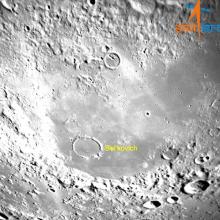Listen to today's episode of StarDate on the web the same day it airs in high-quality streaming audio without any extra ads or announcements. Choose a $8 one-month pass, or listen every day for a year for just $30.
You are here
Moon and Saturn
The Moon has played many roles. It’s escorted lovers, inspired music and poetry, served as both god and goddess, and become a destination for people and machines. And in recent decades, it’s taken on another role: scientific instrument. It helps scientists refine their ideas about gravity. And researchers have proposed a new way for it to do that — by helping detect gravitational waves.
The waves are ripples in space-time. But they’re extremely difficult to sense. Scientists have discovered waves from the mergers of ultra-dense corpses of stars — black holes and neutron stars. But they’re looking for waves from bigger black holes, and even from the birth of the universe.
A team recently proposed a way to use the Moon to help find those waves. It would bounce laser beams off special reflectors on the Moon to measure the Earth-Moon distance. As the waves pass through Earth and the Moon, they could change that distance by a tiny amount. That could confirm the presence of gravitational waves from sources other than those already discovered.
Scientists have actually been doing that work since the Apollo missions. But new missions are expected to take more and better reflectors. That would improve the accuracy of the measurements — providing a new way to find ripples in space and time.
The Moon rises after midnight, with the bright planet Saturn to its upper left. Saturn is above the Moon at first light.





